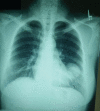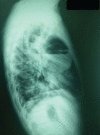Parasitic lung diseases
- PMID: 36450370
- PMCID: PMC9724914
- DOI: 10.1183/16000617.0093-2022
Parasitic lung diseases
Abstract
Parasitic lung diseases are caused by a number of parasites as a result of transient passage in the lung or as a result of an immunologic reaction. The clinical presentation may be in the form of focal or cystic lesions, pleural effusion or diffuse pulmonary infiltrates. With increasing globalisation, it is important to consider parasitic infections in the differential diagnosis of lung diseases. This is particularly important since early identification and prompt therapy result in full cure of these conditions. In this review, we summarise the most common parasitic lung diseases.
Copyright ©The authors 2022.
Conflict of interest statement
Conflict of interest: All authors have no conflicts of interest to disclose
Figures







Comment in
- doi: 10.1183/16000617.0150-2022
References
-
- Santeliz JV. Tropical pulmonary eosinophilia: an epidemiological and clinical review. Int J Respir Pulm Med 2019; 6: 102. doi:10.23937/2378-3516/1410102 - DOI
Publication types
MeSH terms
LinkOut - more resources
Full Text Sources
